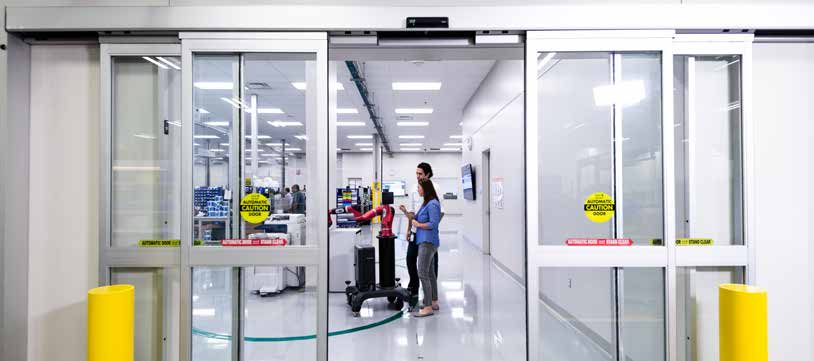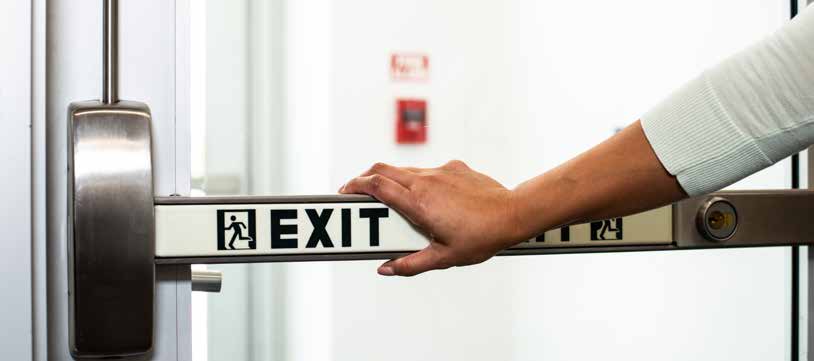Overview
1. This application is meant to be a useful tool in assisting Architects, Consultants, etc. with the following:
A. Determining the occupancy use and type of a building, structure or portion thereof.
B. Calculating the occupancy load for a room or space, for each occupancy type, based on the formulas and tables in the IBC®.
C. Calculating the minimum clear opening width of doors from a room or space.
D. Determining the swing direction of doors from a room or space.
E. Determining the minimum number of exits and exit access doors from a room or space.
2. This application will be a resource in helping determine minimum hardware requirements for side hinged/pivoted swinging doors in a means of egress.
3. This application will be a resource in helping determine hardware requirements for fire and/or smoke rated doors based on the exceptions for each occupancy type as listed in the IBC®.
4. This application is not intended to replace the need for having your own copy of the IBC®, it is intended to be a tool only. To that end, this application is in no way meant to be considered as the interpretation of the compiler, merely it is a transference of the formulae and tables from the IBC® into a useable format.
5. It is important to remember that there are several other Codes that are referenced by the IBC®, this application does not reflect them. In addition, any ammendments made to the code via ICC® supplements, city, state, or jurisdictional modifications, etc. must be taken into consideration by the user of this egress calculator when determining final requirements.
6. It is also important to remember that the IBC® deals with NEW construction only, as defined by the code as follows:
101.2 Scope:
The provisions of this code shall apply to the construction, alteration, movement, enlargement, replacement, repair, equipment, use and occupancy, location, maintenance, removal and demolition of every building or structure or any appurtances connected or attached to such buildings or structures.
Exception:
Detached one- and two-family dwellings and multiple single-family dwellings (townhouses) not more than three stories above grade plane height with a separate means of egress and their accessory structures shall comply with the International Residential Code®.




Occupancy Types
Note: The following information is reprinted from the International Building Code IBC® and is for reference only to help you select the appropriate calculator. Please make sure to check Chapter 3 of the edition you will be using to verify the occupancy type if in doubt. Copyright 2006, 2009, 2012, 2015, 2018, 2021 International Code Council, Inc., Washington, D.C. Reproduced with permission. All rights reserved. www.iccsafe.org
303.1 Assembly- Group A
Assembly Group A occupancy includes, among others, the use of a building or structure, or a portion thereof,
for the gathering of persons for purposes such as civic, social, or religious functions; recreation, food or drink
consumption; or awaiting transportation.
Exceptions:
1. A building used for assembly purposes with an occupant load of 50 or less shall be classified as Group B.
2. A room or space used for assembly with an occupant load of 50 or less and accessory to another
occupancy shall be classified as a Group B or as part of that occupancy.
3. A room or space used for assembly that is less than 750 square feet in area and is accessory to another
occupancy shall be classified as a Group B or as part of that occupancy.
4. Assembly areas that are accessory to Group E occupancies are not considered separate occupancies except when applying the assembly occupancy requirements of Chapter 11.
5. Accessory religious educational rooms and religious auditoriums with occupant loads of less than 100 are not considered separate occupancies.
Motion picture theaters
Symphony and concert halls
Television and radio studios admitting an audience
Theaters
Banquet halls
Night Clubs
Restaurants
Taverns and bars
Amusement arcades
Art Galleries
Bowling alleys
Places of religious worship
Community halls
Courtrooms
Dance halls (not including food and drink consumption)
Exhibition halls
Funeral parlors
Greenhouses for the conservation and exhibit of plants that provide public access
Gymnasiums (without spectator seating)
Indoor swimming pools (without spectator seating)
Indoor tennis courts (without spectator seating)
Lecture halls
Libraries
Museums
Waiting areas in transportation terminals
Pool and billiard parlors
Arenas
Skating rinks
Swimming pools
Tennis courts
Amusement park structures
Bleachers
Grandstands
Stadiums
304.1 Business- Group B
Business Group B occupancy includes, among others, the use of a building or structure, or a portion thereof, for office, professional or service-type transactions, including storage of records and accounts.Includes but not limited to:
Airport traffic control towers
Animal hospitals, kennels and pounds
Banks
Barber and beauty shops
Car wash
Civic administration
Clinic- outpatient
Dry cleaning and laundries: pick-up and delivery stations and self-service
Educational occupancies for students above the 12th grade
Electronic data processing
Laboratories: testing and research
Motor vehicle showrooms
Post office
Print shops
Professional services (architects, attorneys, dentists, physicians, engineers, etc.)
Radio and television stations
Telephone exchanges
Training and skill development not within a school or academic program
305.1 Educational- Group E
Educational Group E occupancy includes, among others, the use of a building or structure, or a portion thereof, by six or more persons at any one time for educational purposes through the 12th grade. Religious educational rooms and religious auditoriums, which are accessory to places of religious worship in accordance with Section 303.1 and have occupant loads of less than 100, shall be classified as A-3 occupancies.Includes but not limited to:
305.2 Day Care
306.1 Factory- Group F
Factory Group F occupancy includes, among others, the use of a building or structure, or a portion thereof, for assembling, disassembling, fabricating, finishing, manufacturing, packaging, repair or processing operations that are not classified as a Group H hazardous or Group S storage occupancy.F-1: Moderate hazard factory industrial- Includes but not limited to:
Aircraft
Appliances
Athletic equipment
Automobiles and other motor vehicles
Bakeries
Beverages; over 12% alcohol content
Bicycles
Boats
Brooms or brushes
Business machines
Cameras and photo equipment
Canvas or similar fabric
Carpets and rugs (includes cleaning)
Clothing
Construction and agricultural machinery
Disinfectants
Dry cleaning and dyeing
Electric generation plants
Electronics
Engines (including rebuilding)
Food processing
Furniture
Hemp products
Jute products
Laundries
Leather products
Machinery
Metals
Millwork (sash and door)
Motion pictures and television filming (without spectators)
Musical instruments
Optical goods
Paper mills or products
Photographic film
Plastic products
Printing or publishing
Recreational vehicles
Refuse incineration
Shoes
Soaps and detergents
Textiles
Tobacco
Trailers
Upholstering
Wood; distillation
Woodworking (cabinet)
Beverages; up to and including 16% alcohol content
Brick and masonry
Ceramic products
Foundries
Glass products
Gypsum
Ice
Metal products (fabrication and assembly)
307.1 High-Hazard- Group H
High Hazard Group H occupancy includes, among others, the use of a building or structure, or a portion thereof, that involves the manufacturing, processing, generation or storage of materials that constitute a physical or health hazard in quantities in excess of those allowed in the control areas constructed and located as required in Section 414. They shall be in accordance with this section, the requirements of Section 415 and the International Fire Code.
Exceptions:
1. Buildings and structures that contain not more that the maximum allowable quantities per control area of hazardous
materials as shown in tables 307.1(1) and 307.1(2), provided that such buildings are maintained in accordance with the
International Fire Code.
2. Buildings utilizing control areas in accordance with Section 414.2 that contain not more than the maximum allowable
quantities per control area of hazardous materials as shown in tables 307.1(1) and 307.1(2).
3. Buildings and structures occupied for the application of flammable finishes, provided that such buildings or areas
conform to the requirements of Section 416 and the International Fire Code.
4. Wholesale and retail sales and storage of flammable and combustible liquids in mercantile occupancies conforming
to the International Fire Code.
5. Closed piping containing flammable or combustible liquids or gases utilized for the operation of machinery or
equipment.
6. Cleaning establishments that utilize combustible liquid solvents having a flash point of 140 deg F (60 deg C)
or higher in closed systems employing equipment listed by an approved testing agency, provided that this occupancy
is separated from all other areas of the building by 1-hour fire barriers or 1-hour horizontal assemblies or both.
7. Cleaning establishments that utilize a liquid solvent having a flash point at or above 200 deg F (93 deg C).
8. Liquor stores and distributors without bulk storage.
9. Refrigeration systems.
10. The storage or utilization of materials for agricultural purposes on the premises.
11. Stationary batteries utilized for facility emergency power, uninterrupted power supply or telecommunication
facilities, provided that the batteries are provided with safety venting caps and ventilation is provided in accordance with
the International Mechanical Code.
12. Corrosives shall not include personal or household products in their original packaging used in retail display or
commonly used building materials.
13. Buildings and structures occupied for aerosol storage shall be classified as Group S-1, provided that such
buildings conform to the requirements of the International Fire Code.
14. Display and storage of nonflammable solid and nonflammable or noncombustible liquid hazardous materials in
quantities not exceeding the maximum allowable quantity per control area in Group M or S occupancies complying with
Section 414.2.5.
15. The storage of black powder, smokeless propellant and small arms primers in Groups M and R-3 and special
industrial explosive devices in Groups B, F, M, and S, provided that such storage conforms to the quantity limits
and requirements prescribed in the International Fire Code.
Explosives
Division 1.1
Division 1.2
Division 1.3 Except materials confined to not heighten the chance of explosion.
Division 1.4 Except articles not regulated as explosive by ATF.
Division 1.5
Division 1.6
Organic peroxides, unclassified detonable
Oxidizers, Class 4
Unstable (reactive) materials, Class 3 detonable and Class 4
Detonable pyrophoric materials
Class I, II, or IIIA flammable or combustible liquids stored in normally open containers
Combustible dusts
Cryogenic fluids, flammable
Flammable gases
Organic peroxides, Class 1
Oxidizers, Class 3 (stored in normally open containers)
Pyrophoric liquids, solids, and gases, nondetonable
Unstable(reactive) materials, Class 3, nondetonable
Water-reactive materials, Class 3
Class I, II, or IIIA flammable or combustible liquids stored in normally closed containers
Combustible fibers, other than densly packed baled cotton
Consumer fireworks, 1.4G (Class C, Common)
Corrosives
Highly toxic materials
Toxic materials
308.1 Institutional- Group I
Institutional Group I occupancy includes, among other things, the use of a building or structure, or a portion thereof, in which people are cared for or live in a supervised environment, having physical limitations because of health or age are harbored for medical treatment or other care or treatment, or in which people are detained for penal or correctional purposes or in which the liberty of the occupants is restricted. Institutional occupancies shall be classified as group I-1, I-2, I-3, or I-4.16 persons or more, 24 hr basis, patients living in a supervised residential environment-
I-1: Includes but not limited to:
Residential board and care facilities
Assisted living facilities
Halfway houses
Group homes
Congregate care facilities
Social rehabilitation facilities
Alcohol and drug centers
Convalescant facilities
Exceptions:
1. A facility such as above with five or fewer persons shall be classified as a Group R-3 or shall comply with the International
Residential Code in accordance with Section 101.2.
2. A facility such as above, housing at least six and not more than 16 persons, shall be classified as Group R-4.
I-2: Includes but not limited to:
Hospitals
Nursing homes (Intermediate and skilled nursing facilities)
Mental hospitals
Detoxification facilities
*Childcare facilities (see exception 2)
The following words and terms shall, for the purposes of this section and as used elsewhere in this code, have the meanings shown herein.
CHILD CARE FACILITIES: Facilities that provide care on a 24-hour basis to more than five children, 21/2 years of age or less.
DETOXIFICATION FACILITIES: Facilities that serve patients who are provided treatment for substance abuse on a 24-hour basis and who are incapable of self-preservation or who are harmful to themselves or others.
HOSPITALS AND MENTAL HOSPITALS:Buildings or portions thereof used on a 24-hour basis for the medical, psychiatric, obstetrical or surgical treatment of inpatients who are incapable of self-preservation.
NURSING HOMES: Nursing homes are long-term care facilities on a 24-hour basis, including both intermediate care facilities and skilled nursing facilities, serving more than five persons and any of the persons are incapable of self-preservation.
I-3: Occupants under restraint or security, 5 or more people. Includes but not limited to:
Prisons
Jails
Reformatories
Detention centers
Correctional centers
Prerelease centers
Condition 1-
Buildings in which free movement is allowed from sleeping areas, and other spaces where access or occupancy is permitted, to the exterior via means of egress without restraint. A Condition 1 facility is permitted to be constructed as Group R.
Condition 2-Buildings in which free movement is allowed from sleeping areas and other occupied smoke compartment to one or more smoke compartments. Egress to the exterior is impeded by locked exits.
Condition 3-Buildings in which free movement is allowed within individual smoke compartments, such as within a residential unit comprised of individual sleeping units and group activity spaces, where egress is impeded by remote-controlled release of means of egress from such a smoke compartment to another smoke compartment.
Condition 4-Buildings in which free movement is restricted from an occupied space. Remote- controlled release is provided to permit movement from sleeping units, activity spaces and other occupied areas within the smoke compartment to other smoke compartments.
Condition 5-Buildings in which free movement is restricted from an occupied space. Staff- controlled manual release is provided to permit movement from sleeping units, activity spaces and other occupied areas within the smoke compartment and to other smoke compartments.
Five or more persons of any age receiving custodial care for less than 24 hrs (not by relatives etc) not in the home.I-4:Include but not limited to:
Adult care facility
Exception:
A facility where occupants are capable of responding to an emergency situation without physical assistance
from the staff shall be classified as Group A-3.
Child care facility
Exception:
A child day care facility that provides care for more than 5 but less than 100 children 2 1/2 years or less
of age, when the rooms where such children are cared for are located on the level of exit discharge and
each of these child care rooms has an exit door directly to the exterior, shall be classified as Group E.
309.1 Mercantile- Group M
Mercantile Group M occupancy includes, among other things, buildings and structures, or a portion thereof, for the display and sale of merchandise, and involves stocks of goods, wares, or merchandise incidental to such purposes and accessible to the public.Includes but not limited to:
Department stores
Drug stores
Greenhouses for display and sale of plants that provide public access
Markets
Motor fuel-dispensing facilities
Retail or wholesale stores
Sales rooms
The aggregate quantity of nonflammable solid and nonflammable or noncombustible liquid hazardous materials stored or displayed in a single control area of a Group M occupancy shall not exceed the quantities in Table 414.2.4(1)
310.1 Residential- Group R
Residential Group R occupancy includes, among other things, the use of a building and structure, or a portion thereof, for sleeping purposes when not classified as an Institutional Group I or when not regulated by the International Residential Code in accordance with Section 101.2.Includes but not limited to:
R-1: Includes but not limited to:
Residential board and care facilities
Assisted living facilities
Halfway houses
Group homes
Congregate care facilities
Social rehabilitation facilities
Alcohol and drug centers
Convalescant facilities
Boarding houses
Congregate living facilities (transient) with more than 10 occupants
Hotels
Motels
Apartment houses
Boarding houses (not transient)
Congregate living facilities (not transient) with more than 16 occupants
Convents
Dormitories
Fraternities and sororities
Hotels (nontransient)
Live/work units
Monasteries
Motels (nontransient)
Vacation timeshare properties
Exception:
Congregate living facilities with 16 or fewer occupants are permitted to comply with the construction
requirements for Group R-3.
Residential board and care facilities
Buildings that do not contain more than two dwelling units.
Adult facilities that provide accommodations for five or fewer persons of any age for less than 24 hrs.
Child care facilities that provide accommodations for five or fewer persons of any age for less than 24 hrs.
Congregate living facilities with 16 or fewer persons.
Exception:
Adult and child care facilities that are within a single-family home are permitted to comply with the
International Residential Code.
Residential care/ Assisted living facilities, more than five up to 16 occupants (excluding staff)
Note:Group R-4 occupancies shall meet the requirements for construction as defined for Group R-3, except as otherwise provided for in this code, or shall comply with the International Residential Code.
311.1 Storage- Group S
Storage Group S occupancy includes, among other things, the use of a building and structure, or a portion thereof, for storage that is not classified as a hazardous occupancy.S-1: Moderate-hazard storage, not classified as S-2- Including but not limited to:
Aerosols, Levels 2 and 3
Aircraft repair hangar
Bags: cloth, burlap and paper
Bamboos and rattan
Baskets
Belting: canvas and leather
Books and paper in rolls or packs
Boots and shoes
Buttons, including cloth covered, pearl or bone
Cardboard and cardboard boxes
Clothing, woolen wearing apparel
Cordage
Dry boat storage (indoor)
Furniture
Furs
Glues, mucilage, pastes and size
Grains
Horns and combs, other than celluloid
Leather
Linoleum
Lumber
Motor vehicle repair garages (complying with Table 307.1(1)- see section 406.6)
Photo engravings
Resilient flooring
Self service storage facility (mini-storage)
Silks
Soaps
Sugar
Tires, bulk storage of
Tobacco, cigars, cigarettes and snuff
Upholstery and mattresses
Wax candles
Includes but not limited to:
Aircraft hangar
Asbestos
Beverages up to and including 12% alcohol in metal, glass or ceramic containers
Cement in bags
Chalk and crayons
Dairy products in nonwaxed coated paper containers
Dry cell batteries
Electrical coils
Electrical motors
Empty cans
Food products
Foods in noncombustible containers
Fresh fruits and vegetables in nonplastic trays or containers
Frozen foods
Glass
Glass bottles, empty or filled with noncombustible liquids
Gypsum board
Inert pigments
Ivory
Meats
Metal cabinets
Metal desks with plastic tops and trim
Metal parts
Metals
Mirrors
Oil-filled and other types of distribution transformers
Parking garages, open or enclosed
Porcelain and pottery
Stoves
Talc and soapstones
Washers and dryers
312.1 Utility and Miscellaneous- Group U
Buildings and structures of an accessory character and miscellaneous structures not classified in any specific occupancy shall be constructed, equipped and maintained to conform to the requirements of this code commensurate with the fire and life hazard incidental to their occupancy.Includes but not limited to:
Agricultural buildings
Aircraft hangars, accessory to a one- or two-family residence (see section 412.3)
Barns
Carports
Communication equipment structures with a gross floor area of less than 1500 SF
Fences more than 6 feet high
Grain silos, accessory to a residential occupancy
Greenhouses (not classified as another occupancy)
Livestock shelters
Private garages
Retaining walls
Sheds
Stables
Tanks
Towers